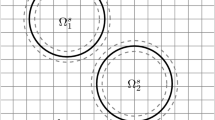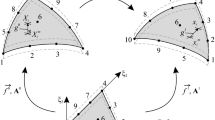Abstract
A new strategy for high-fidelity unsteady mesh adaptation dealing with fluid–structure interaction (FSI) problems is presented using a partitioned approach. The Euler equations are solved by an edge-based Finite-Volume solver whereas the linear elasticity equations are solved by the finite-element method using the Lagrange \({\mathbb {P}}_1\) elements. The coupling between both codes is realized by imposing suitable boundary conditions on conforming meshes even at the fluid–structure interface. Small displacements of the structure are assumed and so the mesh is not deformed. The unsteady mesh adaptation process is based on a unique cavity operator which can handle non-manifold geometry, the fluid–structure interface in this work. The computation of a well-documented two-dimensional test case is finally carried out to perform validation of this new strategy as well as a three-dimensional test case to demonstrate our ability to treat complex three-dimensional test cases.











Similar content being viewed by others
References
Garelli L, Paz R, Storti M (2010) Fluid–structure interaction study of the start-up of a rocket engine nozzle. Comput Fluids 39(7):1208
Farhat C, Lesoinne M (2000) Two efficient staggered algorithms for the serial and parallel solution of three-dimensional nonlinear transient aeroelastic problems. Comput Methods Appl Mech Eng 182(3–4):499
Peskin C (1972) Flow patterns around heart valves: a numerical method. J Comput Phys 10(2):252
Formaggia L, Quarteroni A, Veneziani A (2009) Cardiovascular mathematics: modeling and simulation of the circulatory system, vol 1. Springer-Modelling, Simulations and Applications, New York
Astorino M, Chouly F, Fernández M (2010) Robin based semi-implicit coupling in fluid-structure interaction: stability analysis and numerics. SIAM J Sci Comput 31(6):4041
Alauzet F, Loseille A (2016) A decade of progress on anisotropic mesh adaptation for computational fluid dynamics. Comput Aided Des 72:13
Alauzet F, Loseille A (2010) High order sonic boom modeling by adaptive methods. J Comput Phys 229:561
Alauzet F, Frazza L (2019) 3D RANS anisotropic mesh adaptation on the high-lift version of NASA’s Common Research Model (HL-CRM), In: 25th AIAA Fluid Dynamics Conference (AIAA Paper 2019–2947. Dallas, TX, USA
Langenhove JV, Lucor D, Alauzet F, Belme A (2018) Goal-oriented error control of stochastic system approximations using metric-based anisotropic adaptations. J Comput Phys 374:384
Amari T, Canou A, Aly JJ, Delyon F, Alauzet F (2018) Magnetic cage and rope as the key for solar eruptions. Nature 554:211
Guégan D, Allain O, Dervieux A, Alauzet F (2010) An \({L}^\infty \)-\({L}^p\) mesh adaptive method for computing unsteady bi-fluid flows. Int J Numer Methods Eng 84(11):1376
Alauzet F, Loseille A, Olivier G (2018) Time-accurate multi-scale anisotropic mesh adaptation for unsteady flows in CFD. J Comput Phys 373:28
Alauzet F (2014) A changing-topology moving mesh technique for large displacement. Eng Comput 30(2):175
Barral N, Olivier G, Alauzet F (2017) Metric-based anisotropic mesh adaptation for three-dimensional time-dependent problems involving moving geometries. J Comput Phys 331:157
Vanharen J, Puigt G, Montagnac M (2015) Theoretical and numerical analysis of nonconforming grid interface for unsteady flows. J Comput Phys 285:111
Loseille A, Löhner R (2013) Cavity-based operators for mesh adaptation. In: 51th AIAA Aerospace Sciences Meeting (AIAA Paper 2013–0152. Dallas, TX, USA
Loseille A, Alauzet F, Menier V (2017) Unique cavity-based operator and hierarchical domain partitioning for fast parallel generation of anisotropic meshes. Comput Aided Des 85:53
Vanharen J, Feuillet R, Alauzet F (2018) Mesh adaptation for fluid-structure interaction problems. In: 24th AIAA Fluid Dynamics Conference (AIAA Paper 2018–3244. Atlanta, GA, USA
Alauzet F (2010) Size gradation control of anisotropic meshes. Finite Elem Anal Des 46:181
Felker F (1993) Direct solution of two-dimensional Navier-Stokes equations for static aeroelasticity problems. AIAA J 31(1):148
Blom F (1998) A monolithical fluid-structure interaction algorithm applied to the piston problem. Comput Methods Appl Mech Eng 167(3–4):369
Soria A, Casadei F (1997) Arbitrary Lagrangian-Eulerian multicomponent compressible flow with fluid-structure interaction. Int J Numer Methods Fluids 25(11):1263
Rifai S, Johan Z, Wang WP, Grisval JP, Hughes T, Ferencz R (1999) Multiphysics simulation of flow-induced vibrations and aeroelasticity on parallel computing platforms. Comput Methods Appl Mech Eng 174(3–4):393
Farhat C, Lesoinne M, Maman N (1995) Mixed explicit/implicit time integration of coupled aeroelastic problems: three-field formulation, geometric conservation and distributed solution. Int J Numer Methods Fluids 21(10):807
Cebral J, Löhner R (1997) Conservative load projection and tracking for fluid-structure problems. AIAA J 35(4):687
Giordano J, Jourdan G, Burtschell Y, Medale M, Zeitoun DE, Houas L (2005) Shock wave impacts on deforming panel, an application of fluid-structure interaction. Shock Waves 14(1–2):103
Sanches R, Coda H (2014) On fluid–shell coupling using an arbitrary Lagrangian-Eulerian fluid solver coupled to a positional Lagrangian shell solver. Appl Math Model 38(14):3401
Pasquariello V, Hammerl G, Örley F, Hickel S, Danowski C, Popp A, Wall W, Adams N (2016) A cut-cell finite volume—finite element coupling approach for fluid–structure interaction in compressible flow. J Comput Phys 307:670
Debiez C, Dervieux A, Mer K, Nkonga B (1998) Computation of unsteady flows with mixed finite volume/finite element upwind methods. Int J Numer Methods Fluids 27(1–4):193
Cournède PH, Koobus B, Dervieux A (2006) Positivity statements for a mixed-element-volume scheme on fixed and moving grids. Revue Eur Mec Numer 15(7–8):767
Toro E, Spruce M, Speares W (1994) Restoration of the contact surface in the HLL-Riemann solver. Shock Waves 4(1):25
Shu CW, Osher S (1988) Efficient implementation of essentially non-oscillatory shock-capturing schemes. J Comput Phys 77(2):439
Spiteri R, Ruuth S (2002) A new class of optimal high-order strong-stability-preserving time discretization methods. SIAM J Numer Anal 40(2):469
Newmark N (1959) A method of computation for structural dynamics. J Eng Mech Div 85(3):67–94
Loseille A, Alauzet F (2011) Continuous mesh framework. Part I: well-posed continuous interpolation error. SIAM J Numer Anal 49(1):38
Loseille A, Alauzet F (2011) Continuous mesh framework. Part II: validations and applications. SIAM J Numer Anal 49(1):61
Alauzet F, Frey P, George P, Mohammadi B (2007) 3D transient fixed point mesh adaptation for time-dependent problems: application to CFD simulations. J Comput Phys 222:592
Olivier G (2011) Anisotropic metric-based mesh adaptation for unsteady CFD simulations involving moving geometries. Ph.D. thesis, Université Pierre et Marie Curie, Paris VI, Paris, France
Loseille A, Alauzet F (2009) Optimal 3D highly anisotropic mesh adaptation based on the continuous mesh framework, In: Proceedings of the 18th International Meshing Roundtable (Springer, 2009), pp 575–594
Alauzet F (2016) A parallel matrix-free conservative solution interpolation on unstructured tetrahedral meshes. Comput Methods Appl Mech Eng 299:116
Loseille A (2017) Chapter 10—Unstructured mesh generation and adaptation. In: Abgrall R, Shu C-W (eds) Handbook of numerical methods for hyperbolic problems — applied and modern issues, vol 18. Elsevier, pp 263–302. https://doi.org/10.1016/bs.hna.2016.10.004
Loseille A, Menier V (2013) Serial and parallel mesh modification through a unique cavity-based primitive. In: Proceedings of the 22th International Meshing Roundtable (Springer, 2013), pp 541–558
Frey P (2000) About surface remeshing. In: Proceedings of the 9th International Meshing Roundtable (New Orleans, LO, USA, 2000), pp 123–136
Loseille A, Feuillet R (2018) Vizir: high-order mesh and solution visualization using OpenGL 4.0 graphic pipeline, In: 2018 AIAA Aerospace Sciences Meeting, 2018
Barral N, Alauzet F (2019) Three-dimensional CFD simulations with large displacement of the geometries using a connectivity-change moving mesh approach. Eng Comput 35:397
Acknowledgements
The development of the structure solver and the multi-physics error estimates and strategy was supported by a RAPID DGA program. The development of the non-manifold mesh adaptation is supported by ANR IMPACTS (ANR-18-CE46-0003).
Author information
Authors and Affiliations
Corresponding author
Additional information
Publisher's Note
Springer Nature remains neutral with regard to jurisdictional claims in published maps and institutional affiliations.
Rights and permissions
About this article
Cite this article
Vanharen, J., Loseille, A. & Alauzet, F. Non-manifold anisotropic mesh adaptation: application to fluid–structure interaction. Engineering with Computers 38, 4269–4288 (2022). https://doi.org/10.1007/s00366-021-01435-2
Received:
Accepted:
Published:
Issue Date:
DOI: https://doi.org/10.1007/s00366-021-01435-2




